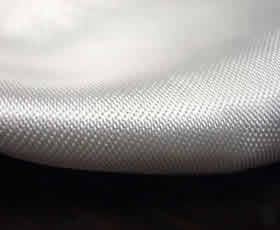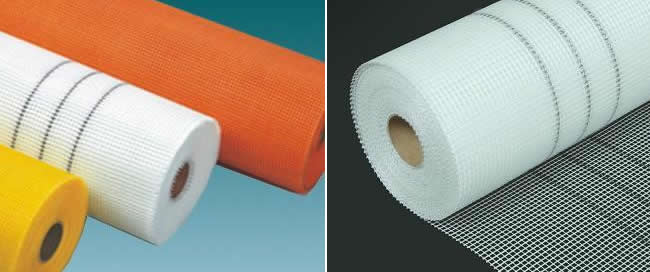Fiberglass Geotextile Non Woven Fabric, Short Fiber PP / PET Needle Punched Geo Textile Fabric, Slope Embankment Reinforcement Geotextile, Drainage Polyester Cloth, Geosynthetic Fabric Used in Infrastructure Geotechnical Construction and Civil Engineering Projects.
Fiberglass fabrics are widely used in the construction industry to reinforce the tensile, impact and flexural strengths of plasters, rendering stuccos, etc. They are also used as fiberglass window screening, swimming pool enclosures, sunshade screening and geo engineering materials. Glass fiber textiles for geo works have high intension, high tenacity, high occlusive force with soil or gravel, excellent erosion-resistance, water drainage, light weigt.
Fiberglass mesh geo textiles are used to reinforce soft soil roadbed, river side slope of embankment, inhibit ground deformation, prevent crack caused by reflection, increase loading capacity of the pavement.
Polyester filament geotextile is made by polyester textile needle consolidation, from 80-800g/m2, it is geosynthetic fabric used in geotechnical and civil engineering. The three-dimensional structure of the fiber has good mechanical properties and a good drainage performance. Synthetic geotextile enjoys good elongation properties, anti-aging chemical stability and high resistance to acid. The geotextile has a wide range of pore sizes and tortuous pore distribution to achieve excellent permeability and filtration performance.
Geotextiles of Fiberglass, PP or Polyester Filament Synthetic Fabric is mainly used in following fields:
1, Water conservancy project dams and slope of filtration, channel isolation, impervious;
2, Highways, railways, airport runways based isolation, filtration, drainage, slopes, retaining walls and pavement reinforcement, drainage;
3, Port engineering soft ground, beach causeway, harbor piers and breakwaters reinforcement and drainage system
Technical data:
| Index | Remark | |||||||||||
| 100 | 150 | 200 | 250 | 300 | 350 | 400 | 450 | 500 | 600 | 800 | ||
| Deviation of mass per unit area % | -6 | -6 | -6 | -5 | -5 | -5 | -5 | -5 | -4 | -4 | -4 | |
| Thickness mm ≥ | 0.8 | 1.2 | 1.6 | 1.9 | 2.2 | 2.5 | 2.8 | 3.1 | 3.4 | 4.2 | 5.5 | |
| Width deviation % | -0.5 | |||||||||||
| Break strength kN/m | 4.5 | 7.5 | 10.5 | 12.5 | 15 | 17.5 | 20.5 | 22.5 | 25 | 30 | 40 | Vertical and horizontal |
| Break elongation % | 40~80 | |||||||||||
| CBR bursting strength kN ≥ | 0.8 | 1.4 | 1.8 | 2.2 | 2.6 | 3.0 | 3.5 | 4.0 | 4.7 | 5.5 | 7.0 | |
| Equivalent aperture mm | 0.07~0.2 | |||||||||||
| Vertical permeability cm/s | K*(10-4~10-3) | K=1.0~9.9 | ||||||||||
| Tear strength kN≥ | 0.14 | 0.21 | 0.28 | 0.35 | 0.42 | 0.49 | 0.56 | 0.63 | 0.70 | 0.82 | 1.10 | Vertical and horizontal |
PP Geotextile/ Fiberglass Geogrid Textile
| Specifications | PET25-25 | PET30-30 | PET40-40 | PET50-50 | PET80-80 | PET100-100 |
| Elongation at break (%) | <=3 | |||||
| Vert Tensile strength(KN/m) | 25 | 30 | 40 | 50 | 80 | 100 |
| Horiz Tensile strength(KN/m) | 25 | 30 | 40 | 50 | 80 | 100 |
| Grid(mm) | 12.5×12.5 20×20 24.5×24.5 | |||||
| Width(m) | 1—6 | |||||

Synthetic filament spunbonded and needle punched nonwoven geotextiles, composite geomembrane, waterproof sheets, geonets, geogrids.
 |
 |
Fiber and polyester filament geotextile has been widely used in the field of infrastructure construction, and gradually be applied to a wider range of fields now.

Reinforcement Fiberglass Fabric
Specifications:
| Mesh size | Density | Width | Length per Roll | Colour |
| (mm) | (gr/m2) | (mm) | (m) | |
| 2*2 | 30-600 | 100-2000 | 10-1000 | All colours |
| 2.5*2.5 | ||||
| 4*4 | ||||
| 5*5 | ||||
| 4*5 | ||||
| 5*6 | ||||
| 10*10 |
